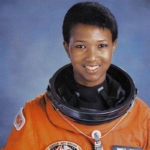
Burçin Mutlu-Pakdil is an astrophysicist at the University of Arizona. She is a 2018 TED Fellow. She grew up in Turkey, where she loved physics and the night sky. She attended school in Turkey and was the first generation of her family to attend college. She completed her undergraduate studies at Bilkent University in 2009 and moved to Texas Tech University for her graduate studies, gaining a Masters degree in 2012. In 2017 she earned her Ph.D., “Testing supermassive black hole scaling relations using cosmological simulations and optical/near-IR imaging data” from University of Minnesota, Twin Cities.
LEDA 1000714 is a ring galaxy in the constellation Crater. LEDA 1000714 is one of a very rare group of galaxies called Hoag-type galaxies– it is estimated that roughly 0.1% of all galaxies are this type. LEDA 1000714 is unusual because it is a Hoag-type galaxy with two nearly round rings, but with different characteristics. It has been nicknamed Burçin’s Galaxy, after Burçin Mutlu-Pakdil, the leader of the photometric study of this galaxy.
“In between the blue outer ring and the red central core, we found a diffused red-colored inner ring surrounding the central body,” she says.
“We were looking at a galaxy that had never been seen before.”
There are about a trillion or so known galaxies in the universe, most of which are spirals like our home galaxy, the Milky Way. While there are solid theories about the evolution of the most common types of galaxies, rare galaxies are of particular interest to astronomers seeking to understand cosmic evolution, Mutlu-Pakdil says. One such rare galaxy is Hoag’s Object, named after Arthur Allen Hoag, who discovered it in 1950. Hoag’s Object was the first known example of a type of ring galaxy with a bright ring of young blue stars surrounding a symmetrical central body made up of older stars, without any visible connection between them. These types of galaxies are extremely rare, comprising less than 0.1 percent of all observed galaxies.
When Mutlu-Pakdil and her team first took note of a little galaxy named PGC 1000714, they mistook it as a Hoag-type galaxy, and they were pretty excited by their discovery. But when Mutlu-Pakdil studied the galaxy further, she was astounded to find that the unusual galaxy had more secrets to reveal.
The celestial body came to be known as Burçin’s galaxy, and it is now providing astronomers with an intriguing mystery: How did such a strange object form in the first place? As with Hoag-type galaxies, the red central core is older than the blue outer ring. But in Burçin’s galaxy, the extra inner ring is the oldest of the lot, indicating that it formed first.

In an interview, Mutlu-Pakdil explained to Inc how fortunate she has been in a family of generations who were unable to attend school. Her grandparents lived in
small farming towns, which meant they never had the chance to learn how to read or write. Her father, although very intelligent in school that he skipped a grade, was forced to drop out after the fifth grade to care for his parents. Her mother also dropped out as the education of girls was not seen at the time as something important in her little village.
Despite her family history with school, Mutlu-Pakdil was able to finish hers and to pursue her passion for the universe. Today, she is one of the most notable astrophysicists out there, a Postdoctoral Research Associate, at Steward Observatory, University of Arizona, and before that a Ph.D. candidate at the Minnesota Institute for Astrophysics. Her findings have been featured in a number of notable publications and news media, such as CNN, Science Daily, Astronomy Magazine, Independent, and MPR News, among many others.
Mutlu-Pakdil’s work studying the structure, formation, and evolution of galaxies has earned her a spot in the 2018 TED Fellows program. She gave her four-minute talk in April 2018 in Vancouver. She also invests in girls and young women through science fairs and professional organizations such as Tucson Women in Astronomy and the American Astronomical Society’s Astronomy Ambassadors program.
Source: Wikipedia. National Geographic. Tucson.com.






